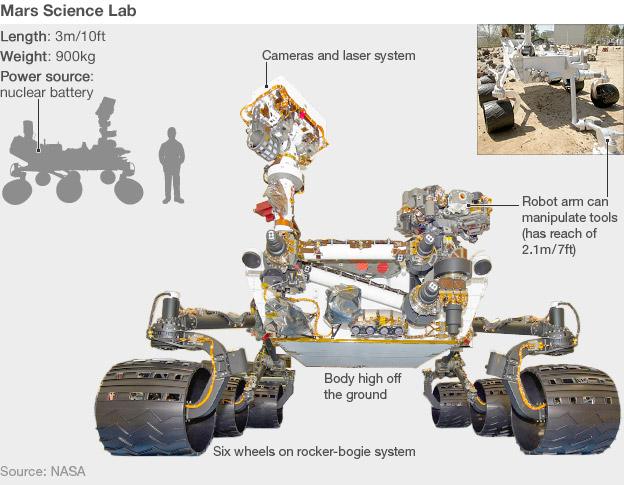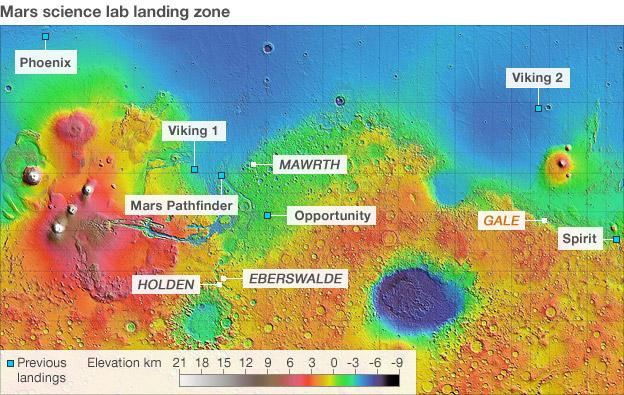Mars rover aims for deep crater
- Published

Nasa has confidence MSL-Curiosity's landing system can put the rover down in a safe spot
Nasa's next Mars rover will be aimed at one of the planet's deepest craters.
MSL-Curiosity weighs almost a tonne and is the size of a Mini Cooper.
It will carry instruments to study whether Mars had the conditions in the past to support microbial life.
The US space agency has selected an equatorial depression called Gale Crater to investigate that question.
The $2.5bn rover will launch from Florida in November.
It should touch-down at the Red Planet in August 2012.
Gale Crater is about 155km in diameter, and its lowest point is about 4.6km below datum, the reference point on Mars from which all other elevations are measured.
The landing zone will be much narrower than the crater's width. But Nasa has high confidence the rocket-powered descent system designed for MSL-Curiosity can put it inside a target zone less than 20km across.
If this Skycrane, as it is known, works as planned, the rover will be delivered close to the central peak of the crater.
This is a huge mountain that contains layers of deposits that should offer an impressive view of millions of years of Martian geological history.
"What we've learnt over 150 years of exploration is that if you start at the bottom of the pile of layers and you go to the top, it's like reading a novel," said mission project scientist John Grotzinger from Nasa's Jet Propulsion Laboratory.
"We think Gale Crater is going to be a great novel about the early environmental evolution of Mars that offers strong prospects potentially for the discovery of habitable environments, and maybe even a shot at discovering organic compounds."
Dr Grotzinger stressed that MSL-Curiosity is not a life-detection mission; it cannot identify microbes or even microbial fossils. But it can assess whether ancient conditions could have supported organisms.
This means Gale must show evidence for the past presence of water, a source of energy with which life forms could have metabolised, and a source of organic compounds with which organisms could have built their structures.
Gale has been chosen because satellite imagery suggests it may well be one of the best places on Mars to look for these biological preconditions.

The Skycrane will lower MSL-Curiosity on to the relatively flat valley floor on the end of tethers before blasting away to a safe distance. The robot will then drive up to the base of the central mountain.
In front of it, the rover should should find abundant quantities of clay minerals that will give fresh insight into the very wet early epoch of the Red Planet. Above the clays, the deposits change to sulphates, which relate to a period in time when Mars was still wet but was beginning to dry out.
In addition, there is evidence water flowed down the mountain at some point in the past, cutting a deep gully and depositing sediments out on the plain.
The rover will get to investigate all of this.
"The suite of things that we can see at Gale represents a diverse number of environments over a long period of time, possibly tens to hundreds of millions of years, plus the modern environment," said Dawn Sumner, a geologist at the University of California Davis, US.
"It's also going to be just an incredibly beautiful place - it will be a lot like the southwest of the US, areas like Monument Valley where you have steep-sided cliffs with the rover going in the shallower valleys between them," the co-chair of the landing site working group explained.
Drop-down mock-up
Gale was selected after a rigorous investigation of some 60 competing sites. The selection process took five years and involved about 150 researchers.
High-resolution imagery was acquired of the best sites, and Nasa even built models of some of the site surfaces and dropped a simulation rover on to them to assess their suitability.
Michael Watkins, the mission's project engineer, said the expected precision of the new entry, descent and landing system meant that the space agency could have chosen any of the top contenders.
"We can control the lift of the vehicle a little bit during entry and we can cancel out some unexpected differences in atmospheric drag that would cause the landing zone to be large," he told reporters.
"Previous missions have had landing zones that have been up to 10 times larger than MSL. MSL is going to land in a 20km-across spot."
MSL-Curiosity has been funded for an initial surface mission of two years. But the fact that Nasa's Opportunity rover continues to roll across the Red Planet today, seven years after landing, suggests the new vehicle may have a very long life ahead of it. What is more, the new vehicle carries a nuclear battery that will provide ample power on a planet where dust storms can blight the operation of solar panels.
MSL-Curiosity is currently being prepared for its November launch at Nasa's Kennedy Space Center.

Site selection whittled possibilities down to four - Eberswalde Crater, Gale Crater, Holden Crater and Mawrth Vallis. Then it went down to Eberswalde Crater and Gale Crater, with Gale winning the final run-off.
- Published25 May 2011